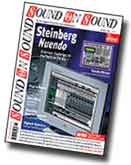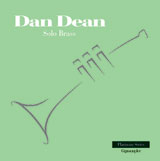|
|

Sound On Sound
Martin Walker
October 2001
Dan Dean's renowned trio of solo instrument titles is now available in the ubiquitous Akai S1000 format. A big hit with the film music community, these libraries (whose Giga-format originals were reviewed in SOS September and October 2001, and January 2002) can now be readily accessed by those musicians who continue to use Akai-compatible samplers.
Rather than create low-alcohol 'Akai lite' versions, Dan Dean has set out to preserve as much of the originals' intoxicating detail as possible. Some compromises were inevitable, and to accommodate the old Akai 32MB limit, the brass and woodwinds multi-dynamics (eight and six layers respectively) have been whittled down to four (each consuming up to 29MB), and the chromatic sampling of their long notes has been reduced to 'white note' intervals. Multiple-dynamic brass and woodwind programs were created by dividing the instrument's range into 'upper' and 'lower', both presented in a choice of (typically) mp/ff or p/mf combinations. This careful programming ensures that the instruments' realism, playability and dynamic expression is unimpaired.
Dan Dean Solo Brass/AKAI
The Akai Solo Brass set spans eight CDs, packaged in a zipped wallet. Eight instruments are included, offering a huge compass that stretches from the deepest reaches of the tuba up to the exalted tones of a piccolo trumpet. The latter, fondly remembered for its contribution to The Beatles' 'Penny Lane', is a splendid little instrument, great for nimble baroque lines and fanfares, and its piping, child-like tone sounds appealing even in the highest registers.
Surprisingly, the concert trumpet manages to match the piccolo trumpet's top note (F6), but sounds a good deal more steely and strident at that altitude. Throughout their range, both instruments (played by the same player) deliver precisely articulated attacks at all dynamics, and their confident, consistent performances will work well in an orchestral setting. The trumpets (and trombone) were also sampled with straight mutes attached, attenuating the tone without getting into Miles Davis territory.
This trombone's four dynamic sustain layers have very different timbres, ranging from a soft warm pp to a piercing ff. To hear all four in action would be a treat, but that requires 109MB of sample memory, well beyond the scope of older Akai models. Moving on down the scale, I live in hope of finding a sampled bass trombone that packs some of the low-end punch of the real thing (remember those belting John Barry arrangements?), but the rather clinical recording style makes this instrument's ff bass notes sound too thin.
A similar problem affects the tuba, which I found slightly nasal and insufficiently fat. Its smaller relative, the euphonium, fares better — a staple of English brass bands, this instrument (also known as the tenor tuba) makes a lovely comfortable, mellow sound in the tenor-bass range, perfect for blending with other brass instruments. The French horn performs well, too — its long notes maintain stable intonation throughout their sustains, and I found only one long note sample (a high C) with questionable pitching in its attack. As with the trombone, the horn's four dynamics span a wide timbral range, and I particularly enjoyed the rather beautiful high register of the quiet sustains — but if you want something more funky, the horn also pushes out some tight, precise staccatos.
Putting in a rare sampled appearance is the cimbasso, a low-pitched, floor-standing contrabass brass instrument, built with valves but no slide. This orchestral oddity has a fruity bass tone, sampled here with a limited range of one and a half octaves rising from F1. Neither euphonium nor cimbasso are strictly necessary for conventional orchestral arrangements, but their subtly differentiated timbres are well worth adding to your instrument collection.
In addition to sustains (which range from four to eight seconds) and staccatos, one-second portato notes are supplied. A comprehensive set of changing-dynamic performances (forte-piano and forte-piano crescendos of three different lengths, all played with good positive attacks) are an even stronger selling point, adding mobility, sonic realism and a bit of pop attitude to arrangements. The eight instruments are played without vibrato, and the trumpets also offer vibrato as an option at absolutely no extra cost.
Unlike his recent Brass Ensembles release, these recordings are not soaked in a spectacular concert hall ambience — made in Dan's own studio along with his other solo instrument titles, the samples sound close and dry. If you want reverb, dial up your Lexicons!
Summary
Budget 'Giga lite' versions of the Solo Brass and Woodwinds accompany the new Akai releases. Sampled at minor thirds and reduced to two velocity layers, these omit the alto and bass flutes, contrabassoon, euphonium and cimbasso.
Dan Dean's reformatted titles maintain his usual high standard, offering solid, consistent performances, clean, bright sound quality, no-nonsense programming and clear, detailed documentation in traditional print format. The lack of loops throughout remains a handicap, and you'll find no grace notes, glissandi, chords, riffs, runs or other performance frills. But don't let that deter you — these are comprehensive instrumental collections with a lot to offer the serious orchestrator, and their subtle dynamic and timbral variations have yet to be surpassed.
|
|
 |
|
|
|
> Read the "Electronic Musician" review.
> Read the "Sound on Sound" review. |
|
Stewart Winter - VideoHelper Inc
|
|
"Amazing. I can't say enough great things about the collection. It's definitely becoming a staple in our orchestral arrangements (we do music forWorld News Tonight for ABC News, Dateline, ER, and stuff like that) -- andwe have EVERY kind of brass sample out there -- including access to a bunch of really great horn players."
|
|



